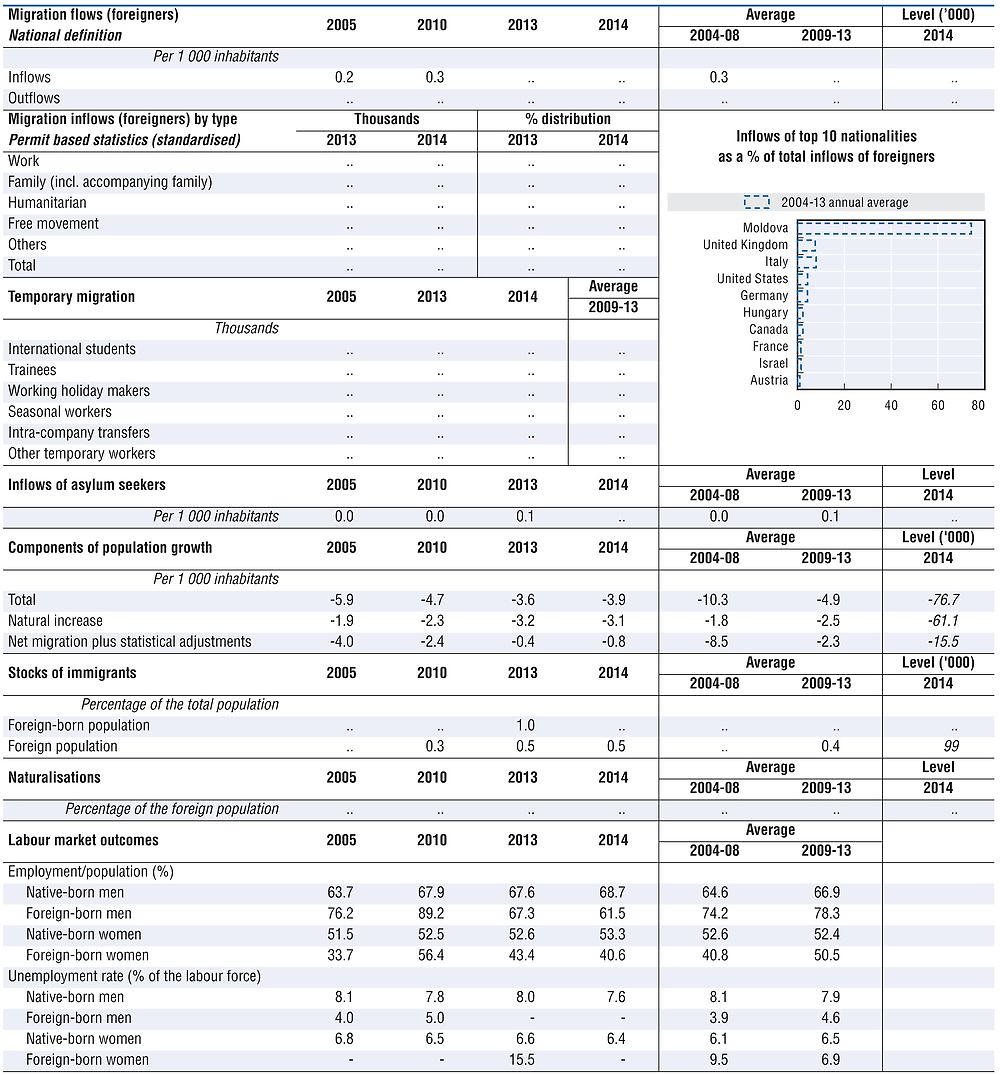Romania
After high net emigration from Romania following the country’s accession to the EU, official statistics on temporary and permanent migration inflows (172 700 persons, the majority of whom were returning Romanians) approached those on outflows (184 100) in 2014, leaving a net emigration of 11 000 persons.
In 2014, foreign residents accounted for 0.5% of the total population. Their number had fallen from 102 800 in 2012 to 98 600 in 2014, and of the latter 57 500 were third-country nationals. The main countries of origin were Italy (11 400), the Republic of Moldova (9 900), Turkey (8 800), China (7 400) and Germany (5 200). As in previous years, migrants who arrived through family reunification, together with those who were family members of a Romanian citizen, formed the majority of the immigrant population. More than half of the migrants were aged under 35, and around 60% were men.
Romania sets annual quotas for work authorisations to be issued, although historically demand has been lower than the quotas. For both 2014 and 2015 the quotas were set at 5 500, including 3 000 permanent workers; 900 intra-corporate transfers; and 900 other highly skilled migrants. In 2014, 2 300 visas were issued (compared to 2 100 the previous year); of these, 1 700 were granted to permanent workers. Estimates of the number of EU/EEA citizens posted to Romania fell to 4 700 in 2014. Hungary, Poland, Italy and Germany were the main countries of origin.
The number of migrants entering Romania for study has been growing. Data from the National Institute of Statistics show that the number of foreign students for the academic year 2013/14 in Romania was about 21 000; more than 14 000 students were from countries outside the European Union, including over 6 000 students from the Republic of Moldova.
According to Eurostat data, the number of asylum seekers (first requests) fell from 1 500 in 2014 to 1 200 in 2015. The main groups were from Pakistan (250), Iraq (170) and Bangladesh (170). A third of the 500 decisions taken at first instance were positive in 2015, compared to 51% on average in the EU. In addition, the government announced in September 2015 that Romania could receive around 1 500 refugees on a voluntary basis.
The number of migrants transiting through Romanian territory as a gateway to the Schengen Area increased, reflecting the situation in North Africa, Ukraine and the Middle East. Irregular migration increased at the borders with the Republic of Moldova, Ukraine and Serbia in 2014 and 2015. In 2015, around 1 500 foreigners who tried to cross the border illegally were detected, mostly at the borders with the Republic of Moldova and Serbia. Most of them came from Syria, Afghanistan, Iraq, Pakistan and Iran.
At the end of 2014, 3 million Romanians were estimated to be working or studying in another EU country. Spain and Italy were their main countries of destination, with around 2 million Romanians settled in one of those two countries for at least one year.
In 2014, a new National Strategy on Immigration was introduced. Measures were designed to attract highly skilled workers; to facilitate the access of foreigners to the country’s higher education institutions; to offer possibilities to highly skilled third-country nationals to search for a job in Romania at the end of their studies; to adopt a stricter approach to irregular immigration and readmission; and to adopt a better asylum policy.
Government Ordinance (GO) 25/2014 transposed into the national legislation EU Directives 2008/115/EC on common standards and procedures in member states for returning illegally staying third-country nationals, and 2011/98/EU on a single application procedure for a unique permit for third-country nationals to reside and obtain employment in the member states, and on a common set of rights for third-country workers legally residing in a member state. GO 25/2014 also introduced amendments to the employment and posting of foreign workers in Romania, and set conditions for the employment of permanent, seasonal and cross-border workers, interns, and highly skilled workers.
Additional categories of third-country workers will be exempted from a labour market test. In particular, this will be the case for those who have been residing legally in Romania for at least three years as family members of Romanian citizens; those having a right of temporary residence for studies; and holders of a long-term residence permit.
Government Decision No. 691/2015 approved a new procedure concerning care and education services for children whose parents work abroad.

